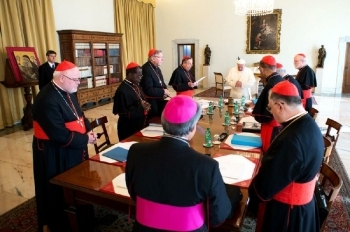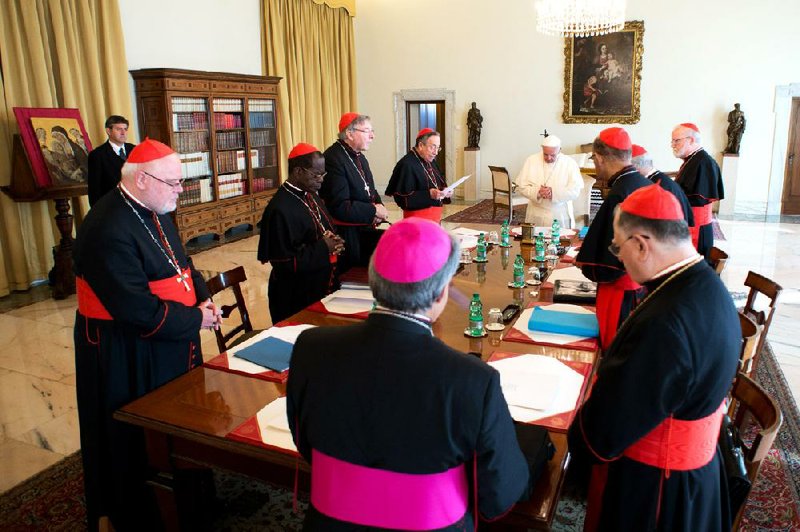
.jpg) Mathew Paikada
Mathew Paikada

The growth of any organism involves change and it would necessarily involve a tension between giving up something and taking up something else. The present Apostolic Constitution “Predicate Evangelium” of Pope Francis that would replace “Pastor Bonus” (1988) of Pope John Paul II is symptomatic of such growth in the self-understanding of the Church. As the title itself indicates, it is not the person of “the Good Shepherd”, but the communitarian task of “preaching the Gospel” that is central to the new Constitution. “Pastor Bonus” contained almost ten years of experience and involvement of Pope John Paul II; similarly, almost nine years of pontifical experience and directives of Pope Francis is behind the present Constitution “Predicate Evangelium”. The new Constitution, promulgated on 19th March by Pope Francis, will enter into force on 5th June 2022.
The Second Vatican Council did not have any serious issues to settle on Christology, Trinity, sacraments or Mariology. The rift between the so-called progressive and conservative theologians in the Council was evident mostly on ecclesiological perspectives. Church as an inward-looking mystery-ridden mystical body of Christ organized on a hierarchical basis was on the one side. The perception of an outgoing Church as a pilgrim people of God, encountering the secular realities of the world at every step, while marching towards the Parousia (second coming) was on the other side. The decision to have two Constitutions – one dogmatic and another pastoral – was a compromise that was not satisfactory for many theologians including Karl Rahner.
The teaching of the Popes in the subsequent decades showed a clear preference for the pastoral constitution “Church in the Modern World” (GS). Another important post-conciliar shift of emphasis was from the focus on “care of souls” by the clerics to an involvement of the whole Church in the issues of justice, peace and integrity of creation as an integral part of evangelization. However, it did not mean any watering down of the sacramental or liturgical life of the Church. It was the new understanding of the life and ministry of the Church. Evangelization itself was no more considered a corollary to Church’s manifold functions, but the central task or even the very reason for the existence of the Church. The growing self-esteem of the laity, especially women, and a widespread disdain for clericalism as well as ritualism was another trendsetter. These approaches mentioned above are reflected in the new Constitution. The pastoral priorities of the Pope Francis find clear ex
Main characteristics
The new Constitution, in the opinion of the experts, reflects a new philosophy and a pastoral turning point in the Catholic Church. Pope Francis has been already putting these ideas into practice in the past few years of his pontificate. Far from being a pure legal document of guidelines for administration of Vatican Curia, this constitution has a clear spiritual pastoral flavor. First of all, in the preamble to the Constitution it is clearly said that every member of the Church is called to be ‘a missionary disciple’ of Jesus Christ.
Evangelization, both ad gentes and ad intra (re-evangelization) should be at the heart of the Church and it should be reflected in the life, activity and administration of the Church.
Secondly, every member of the Church can have a part in the administration of the Church, within the limits of power of ordination in certain departments. At the level of administration, the service of qualified men and women -- lay, cleric or religious persons from anywhere in the world – should be welcome for the good of the people of God.
Thirdly, a spirituality of humble service, devoid of clericalism, careerism, regionalism and patriarchal domination, should be guaranteed in the administrative apparatus of the Roman Curia.
Fourthly, the Roman Curia does not place itself between the Pope and the Bishops; rather, it places itself at the service of both in ways that are proper to the nature of each.
Fifthly, National Bishops’ Conferences will be empowered under the new reform, in the sense that the Roman Curia will undertake greater consultation with them before making major decisions that affect them. The cultural euro-centrism will be replaced by a global cultural pluralism in the Church. Serious difficulties had arisen with regard to the English translation of the New Text of the Holy Mass. (However, the role of Bishops’ Synod is not well integrated into the administrative system).
Sixthly, transparency and accountability on financial administration is given a face-lift in order ensure credibility and avoid opportunities for scandals. The Vatican Bank had got submerged in serious financial scandals involving Archbishop Paul Marcinkus, the powerful Vatican insider, and the banker Roberto Calvi suspected of mafia connections in the 1970s and 80s; the latest scandal was related to money laundering and unethical investment in London real estate. Finally, the pope insists that the revamping of the structure in the Spirit of the Gospel should go hand-in-hand with personal holiness of the office-bearers.
Streamlining Departments
It is not easy to refute the fact that the administrative structure of Vatican Curia is very much outdated and not very transparent. There were confusions regarding the competency, responsibility, overlapping jurisdictions, subsidiarity, accountability, etc. The Swiss Capuchin Missiology Professor, Walbert Buehlmann, had pleaded for encouraging the development of “a mysterium Liberationis” from Latin America, “a mysterium Incarnationis” from Asia, and “a mysterium inculturationis” from Africa, in the way “a mysterium Salutis” emerged and developed in Europe. In fact, a cultural and personnel globalization is taking place in the Catholic Church.
However, although various attempts were made by Popes Paul VI and John Paul II in the spirit of aggiornamento (updating) of Vatican II, it did not bear the desired fruit. Probably the case of USSR, with its ‘glasnost ‘and ‘perestroika’ under the leadership of Mikhail Gorbachev that led to the disintegration of the Soviet Empire, was not an attractive model! Probably the centers of power in Vatican resisted decentralization and re-structuring for fear of disintegration of the mighty monolithic structure of the Church. They preferred the exclusive instrumentality of the Church for Salvation, rather than the universality of salvation and the collaborative instrumentality and responsibility of the Church for the entire people of God (whole humanity on earth) and a humble openness to the ever-active Holy Spirit, who cannot be bridled and domesticated.
The new Constitution for the administration of the Roman Curia flows from the basic ecclesial principle drawn up from the life of Jesus, that authority is for service and liberation of the people of God and not for control of the people. The Church is called to be leaven in the world; it is not to make the whole world into leaven. Jesus is the light of the world and the Church is called to reflect that light in and through the lives of its members. Hence the administrative apparatus should have an irreplaceable and unmistakable spiritual (Jesuanic) quotient, affirms Pope Francis.
What is new in the Constitution?
On the basis of “Pastor Bonus” the various departments of Roman Curia were organized into two secretariats (Secretariat of State, Secretariat of Economy), nine congregations, three dicasteries, three tribunals, five Pontifical Councils and three offices, etc. The present Constitution “Predicate Evangelium” brought together most of the above offices into a standard nomenclature “dicasteries” (16), which means simply departments, by merging some of the old areas of administration or raising some of them from offices to independent ‘dicasteries’.
The Secretariat of State continues to be the most powerful office, though there have been attempts to trim its extensive powers. The first and the second in the list of dicasteries are that of Evangelization and that of Doctrine of Faith. While these decasteries retain their key positions, they have undergone some merging and unions. Most significantly, the Pope himself will head the dicastery for Evangelization, although the day-to-day affairs will be monitored by pro-prefects.
The dicastery for Doctrine of Faith has two dimensions – disciplinary and doctrinal. The crime of sexual abuse of children (and the protection of minors and vulnerable adults) is brought under this department, because it is considered a crime against faith. Cardinal Sean O’Malley of Boston, the papal point man for sexual abuse, hailed this as a firmer foundation for the Church’s fight against sexual abuse. It is clearly intended to be that. The dicastery for the Doctrine of Faith, formerly known as the Holy Office or “La Suprema”, is moved to the second place, while the dicastery for Evangelization takes the prime place.
The third in the list of dicasteries is the upgraded ‘office of papal charities’, which lies close to the heart of Pope Francis. This has reference to Pope Benedict XVI, who pointed out the triplex ex
The fourth is the dicastery for the Oriental Churches which had only very limited autonomy and often considered an appendix to the numerically powerful Latin Church. Raising its status and freedom of operation for the Oriental Churches is a positive signal and invitation to the separated Churches and justice to the non-Latin sui juris Churches with ancient tradition, on the basis of the understanding clearly defined in the Second Vatican Council and affirmed in many later documents: Catholic Church is a communion of Western and Oriental Churches, equal in dignity.
One of the most significant changes is the possible inclusion of more laity and women in authoritative positions in the Curia, and a more international mix of curial officials. Along with the increasing role of women in the leading positions in the Church, ‘the women genius’ should be brought to the thinking (theology) and organization of the Church. However, it is not clear which dicasteries can be headed by laity and which can’t be. There is also a clear absence of significance lent to the Synod of Bishops, which has been gaining prominence in the administrative structure of the Church. With the introduction of maximum two five-year terms to the clergy in the Vatican offices, Pope wants to give a strong signal against careerism of the clergy in the administration.
“Predicate Evangelium” can be seen as reflecting the most comprehensive vision of Pope Francis on the Roman Curia and the administration of the Church. Beneath all these reforms we find an emphasis of Pope Francis on the proper interior disposition of all those serving in the Roman Curia and their personal, ongoing conversion along with the external structural reforms. However, every dicastery is yet to find clarity in internal governing norms and structures of inter-dicasterial collaboration and consultation. With the usual resistance to change, transparency, collaboration and accountability, the reform of Roman Curia will, at best, be a work in progress.
(E-mail: paikadam@gmail.com)